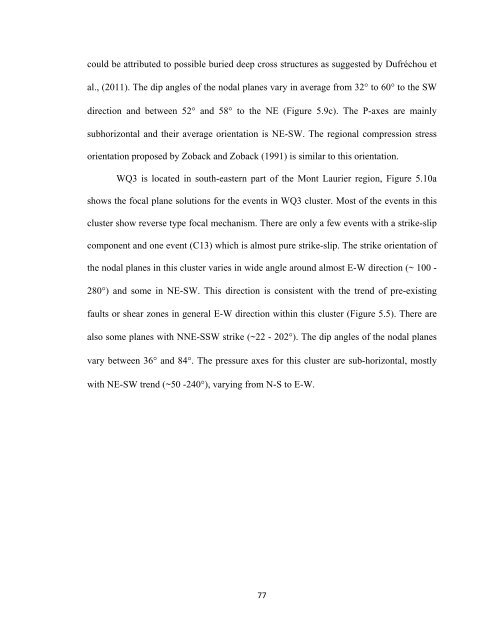western quebec and southern ontario - Department of Geology
western quebec and southern ontario - Department of Geology
western quebec and southern ontario - Department of Geology
You also want an ePaper? Increase the reach of your titles
YUMPU automatically turns print PDFs into web optimized ePapers that Google loves.
could be attributed to possible buried deep cross structures as suggested by Dufréchou etal., (2011). The dip angles <strong>of</strong> the nodal planes vary in average from 32° to 60° to the SWdirection <strong>and</strong> between 52° <strong>and</strong> 58° to the NE (Figure 5.9c). The P-axes are mainlysubhorizontal <strong>and</strong> their average orientation is NE-SW. The regional compression stressorientation proposed by Zoback <strong>and</strong> Zoback (1991) is similar to this orientation.WQ3 is located in south-eastern part <strong>of</strong> the Mont Laurier region, Figure 5.10ashows the focal plane solutions for the events in WQ3 cluster. Most <strong>of</strong> the events in thiscluster show reverse type focal mechanism. There are only a few events with a strike-slipcomponent <strong>and</strong> one event (C13) which is almost pure strike-slip. The strike orientation <strong>of</strong>the nodal planes in this cluster varies in wide angle around almost E-W direction (~ 100 -280°) <strong>and</strong> some in NE-SW. This direction is consistent with the trend <strong>of</strong> pre-existingfaults or shear zones in general E-W direction within this cluster (Figure 5.5). There arealso some planes with NNE-SSW strike (~22 - 202°). The dip angles <strong>of</strong> the nodal planesvary between 36° <strong>and</strong> 84°. The pressure axes for this cluster are sub-horizontal, mostlywith NE-SW trend (~50 -240°), varying from N-S to E-W.77
















